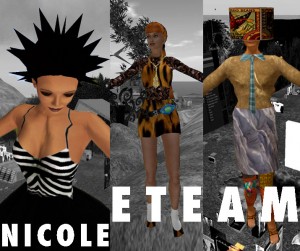
ETeam is comprised of Hajoe and Franziska. They were introduced to me by Cary Peppermint, who met them at an exhibition they all participated in, called Ebay. ETeam’s work includes mainly long-term projects, wherein time is just as much an artistic component of the final result as anything else… Just look at 1.1 Acre or International Airport Montello.
To learn more about Hajoe and Franziska, visit their website here.
However, one of ETeam’s projects spoke to me above all the rest: a dumpster created for the virtual reality world Second Life. After viewing ETeam’s Second Life dumpster project (read the blog here) and having viewed Art21’s Season Five segment on Cao Fei, I thought it was only fitting that the three of us should meet in Second Life, at the dumpster, for our interview. Second Life, for many, is more than just a fantasy get away; it’s a chance at an ideal life in an Utopian society. It’s hard to really negatively judge another avatar’s looks when half of the population is running around as robots or monster/people hybrids. In Second Life, you can have any occupation you want, any day of the week; own any piece of water-front property that you’d like; any first name you’d like; even have as many relationships with as many different partners as possible (if that’s your thing, of course).
Artists have been interfacing with Second Life in unique and interesting ways, but what struck me most about ETeam’s approach, and what always seems to strike me about art that deals with Second Life, is that ETeam was imbuing this utopian ideal with a small piece of dirty reality. Dumpsters represent progress and the maturation of our societies insofar as there are more benefits to sequestering waste to a limited area away from where people spend their lives. On the other hand, now that society has matured to a point considerably removed from the days when poo and disease-ridden corpses were flung about (Ring Around the Rosie, anyone?), the very same landmark that represented social progress has now come to signify social irresponsibility. Dumpsters, or more specifically landfills, pose a real threat to both environment and society alike. No one wants to live near a landfill (clearly) but at the same time, the amount of garbage produced by the average American home is making the demand for more and more landfills increasingly high. Beyond this, landfills also produce toxic emissions, the two most concerning ones being hydro and atmospheric emissions. Through atmospheric emissions, landfills have largely contributed to the depletion of the ozone layer. Furthermore, landfills can leak into nearby streams or simply be absorbed into the ground, and eventually end up in YOUR drinking water or polluting our freshest sources of water below the Earth’s surface. (Read more about the environmental implications of landfills here.)
The flip side of all this horror and ugliness is that under the growing threat of global warming and Al Gore, our society has been inspired to right the wrongs of landfills. Many institutions are experimenting with running their facilities off of landfill emissions, and efforts to increase recycling are at an all-time high. It would almost seem that we’ve come back full circle, and the problem of the landfill will soon enough shed its skin, as human horror to come to signify human progress once more.
All this, of course, reminds me of Eco Art Tech’s Eclipse, 2009 project, and our discussion of “pretty pollution.” (Listen to our conversation here for a refresher.) I couldn’t help but wonder (yes, that’s a SatC reference)…Would ETeam have a similar opinion on networks and systems as EcoArtTech? Are we all so imbued in the system/network that this whole project will only produce one definition of systems and networks, repeated over and over again?




Pingback: What’s Cookin at the Art21 Blog: A Weekly Index | Art21 Blog
Pingback: Flash Points: Art + the Environment Wrap-Up | Art21 Blog